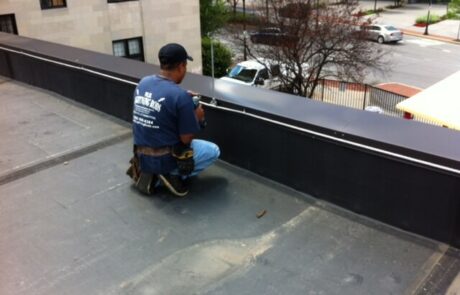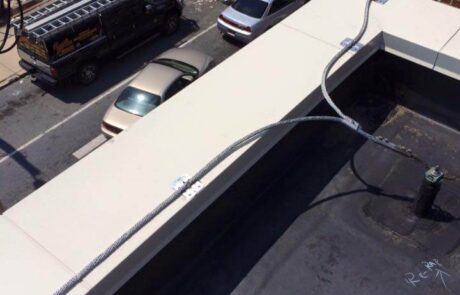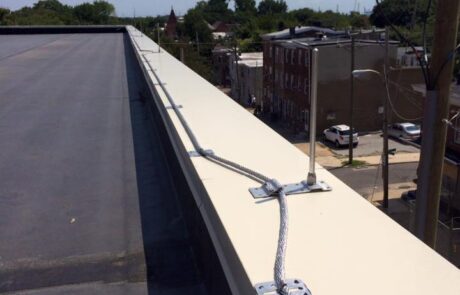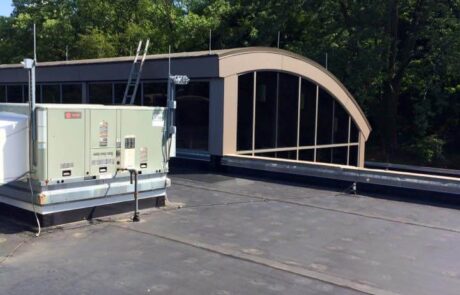Call 1-800-557-9037 For Lightning Protection Solutions
Industrial and Commercial Lightning Protection Systems
Industrial and commercial property owners are choosing lightning protection systems for their structures as part of the overall security package to protect property, inventory, electrical equipment and precious human life.
Local lightning strikes are inevitable, regardless of whether or not you have installed a lightning protection system in your commercial building. At WB Lightning Rods, our top priority is to ensure your safety. Typically, lightning strikes the highest point in the immediate vicinity, which is often a commercial building. Structures made of wood or other combustible materials that are not conductors of electricity will suffer significant electrical and heat damage, or may even catch fire. Lightning rods help protect your commercial assets, employees and guests by redirecting electrical currents away from the building, preventing fires, and protecting electrical devices from being “fried” by lightning. WB Lightning Rods is one of the largest privately owned lightning protection company in the United States. We have been providing industrial and commercial lightning protection systems since 1950 and spanning across 3 generations. Get a free quote today and let us do the rest!
Need more information? Please fill out the form below and we will get back to you promptly.
Commercial Lightning Protection Systems by WB Lightning
About Commercial Lightning Protection Systems
Electricians usually use the same main groups of components to install lightning protection apparatus on most commercial, industrial and government buildings and structures as well as residential places.
As these structures are more complex and extensive than their residential counterparts, the lightning protection systems should be more extensive. In fact, if the building height surpasses 75’ above grade, appropriate cables and components should be larger and heavier.
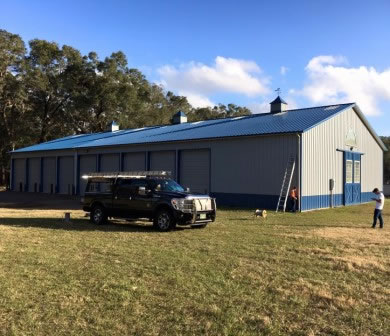
Air Terminals
Just like in residential buildings, commercial lightning protection systems, also referred to as “strike termination devices”, sit at the very top of the structure where initial contact between the protection system and the discharge occurs. In the recent past, the industry, including Thompson, has embraced blunt air terminals or terminals with rounded tips at the expense of conventional sharp-tipped terminals.
This comes from a study by the University of New Mexico’s Dr. Charles B Moore. He discovered that rods with blunt tips of 1” diameter are more efficient in lightning arresting as compared to their sharp-pointed counterparts.
When a building surpasses 75’, it should adhere to a certain code. For example, this code states that air terminals made of copper adjust from 3/8” of minimum diameter for Class 1 system (structures under 75”) and ½” minimum diameter for all structures over 75’.
On the other hand, air terminals made of aluminium adjust from ½” minimum diameter in Class 1 to 5/8” minimum diameter in Class 11. The industry provides a wide range of air terminals and mounting bases for use in different building configurations. If these are not available, WB Lightning Rods will provide these.
Conductors
These are specialty cables, as they conduct the strike of lightning from air to ground. Once the 75’ mark has been attained, the size of copper and aluminum cables increases steadily. Actually, their weight doubles per every 1000’ and circular area.
Electricians can use either aluminum or copper conductors depending on the conditions and preferences of the project. The law provides specific code criteria to restrict the use of dissimilar metals. For example, unless there are special bimetal fittings, electricians can neither splice nor mount copper and aluminum on opposite metal.
Additionally, they cannot mount copper on galvanule, plated and galvanized steel surfaces. Everyone in the industry must note that the cables in commercial lightning protection systems must come with special multi-strand manufacture. While they cannot be rated by ordinary AWG sizes, it is prudent to refer to catalogues and codes to obtain further knowledge.
Bonding
Splicers and fittings utilized to make connections for preventing side flashes in Class 11 applications must feature a heavier construction. They should be made of either copper, aluminium or bronze and must have connections for bolt pressure. Usually, Class 11 systems do not use the hand crimp fittings for Class 1. Further, buildings over 200’ tall utilize very extensive and special bonding mechanisms.
Ground
The fittings for commercial, industrial and Class 11 buildings usually use extensive and substantial grounding methods. These include cable grids and buried plates instead of driven rods. In fact, some structures use these in combination with enhanced driven rods for increased strength and protection. In other instances, structures employ encapsulation products and chemical backfill to reduce the general resistance that the systems typically have.
Surge Arresters
Every increase in building size, a height and service load comes with a corresponding need for larger and stronger surge protection devices for all incoming services. This is because electrical designers need to shove all over-voltages on the lines to the ground. For this reason, the designer must be actively responsible and involved in the specification and selection of appropriate lightning arrester apparatus for each structure.
Special Items
In special cases, there are additional items categorized as special items. In addition to air terminals, conductors, bonding, ground and surge arrestors, which protect adjacent trees, an electrical designer may need to introduce satellite dish antennas, platforms, handrails, oversize mechanical apparatus and other special rooftop equipment. Evidently, the installation and maintenance of commercial lightning protection systems should be approached with the seriousness it deserves.
Why We Do It Better
Lightning protection is a very specialized field within the construction industry. To ensure your lightning protection system is properly installed and offers the protection it should, it is vital to hire an installation professional. We have the following certifications & credentials.
- Rated A+ with the Better Business Bureau (BBB)
- Licensed & Insured
- National Fire Protection Association (NFPA) Member
- Educated in UL 96A; NFPA 780; and LPI 175
- Voted Home Advisor Top Rated
- Awarded Elite Service Professional On Home Advisor
- Best of Home Advisor Winner 2016
Call 1-800-557-9037 For Lightning Protection Solutions

